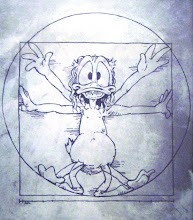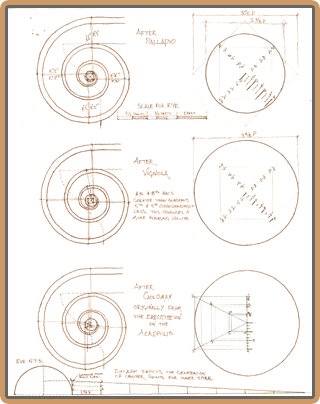 Originally, under the design of the previous architect Santiago Calatrava, the two walls of the Cathedral were to open...like hands in prayer. So, if parishioners held their head high in prayer, then it would have rained down their noses.
Originally, under the design of the previous architect Santiago Calatrava, the two walls of the Cathedral were to open...like hands in prayer. So, if parishioners held their head high in prayer, then it would have rained down their noses.Thank Goodness Calatrava was fired. But who did they hire next? Craig Hartman of the modernist powerhouse firm S.O.M. What were his principles that made him worthy of taking over the second most expensive Cathedral project in America (and $80 million over budget!)? According to Hartman:
"The tradition of the Catholic Church has historically been to apply the most advanced architectural thinking to create works of architecture that illuminate, inspire and ennoble the human spirit."Right. Because the eschatological goal of the Mass (you know, that thing that happens in this kind of architecture) is for illuminating, inspiring, and ennobling the human spirit. Straight from the mouth of an agnostic comes another historical, philosophical, metaphysical, and theological blunder which erroneously promotes the anthropocentrism of rationalism. Phew. That's much easier to read to yourself than aloud.
I think one of the most important aspects of this issue, and the one that strikes me most now that the Cathedral is finished, is it's presence in the city of Oakland, and the metaphor this becomes for the state of ecclesiastical architecture everywhere. Let us start with calling to mind Christ's words on the mount (especially because we're talking about the Cathedral of Christ the Light):
You are the light of the world.Of her hometown Oakland, Gertrude Stein famously noted that "There is no there there." But of modern society we can say 'there is no prayer there'. Men and women bustle about downtown skyscrapers, office workers drone on in the vast oceans of concrete found in office parks across the country. Rarely, if ever, do they hear the ringing of the bells marking the liturgy of the hours. Rare is the visual reminder that they are called to higher things as they drive past a church, and when we build churches like the new Cathedral of Christ the Light, we are accentuating the problem. Our churches are not inviting people into them. Most of the time, people don't even know what that building is, and what it's for. 'Is it a dentist's office?' 'Is it a museum?' 'Is it a hospital?' 'Oh, THAT'S A CHURCH?!?!?! I never would have guessed!'A city set on a mountain cannot be hidden.
Nor do they light a lamp and then put it under a bushel basket;
it is set on a lampstand,
where it gives light to all in the house.
Just so, your light must shine before others,
that they may see your good deeds
and glorify your heavenly Father.
–Matthew 5:14-16
But you may ask 'why is it so important to spend a lot of money on a church to make it look beautiful?' There are lots of reasons, but here are some thoughts that are often overlooked.
One of the arguments that modernist architects often make is that the form, and not ornament, should speak to the viewer. OK. But do YOU really see a VESICA PISCIS in that building? No. You'd have to see a plan drawing of it. And because it's devoid of ornament, there's nothing else to go by. So, a slightly well read modernist would give you the sophistical argument that 'The church buildings of early Christianity were often bare. They were houses. They did not adorn their exterior because they knew it was not what you looked like on the outside, but rather the inside i.e. the state of your soul that counts.
OK, but this is misleading. The very early Church did not adorn its buildings because the people in those domi ecclesiae were being persecuted, and didn't want to call attention to themselves. They did use symbols that were ambiguous, so that they could be argued out of. Later, when Christianity was accepted and promoted, and all of Europe was Catholic, there was no need to call attention to one's self. There was little need to be a 'light' to a world that was already lit.
But with the advent of the protestant reformation, there became an increased need to represent to an increasingly unfaithful population the realities of what exists on the inside of churches-churches that reformers were no longer seeing the inside of. Thus, the genius of Bernini's collonade at St. Peter's, a welcoming gesture to all.

But now, with increased secularism, it is even all the more important for our churches to call attention to themselves to those that pass by. If nothing else, maybe those passers-by will wonder why so much effort was spent in building a beautiful House of God. Maybe they'll stop in, curiously, and find more beauty. And then our city on a hill, our lamp on a lampstand will bring prayer there.
I wish I could have seen it at night--we were there at 10 in the morning--because apparently it lights up like a lightbulb. The reality is no one, absolutely no one, is anywhere near that part of Oakland at night. It won't be able to succeed in inviting people in because there's no one there to see the invitation. And in the daytime, when people are there, it fades away into the same blah urban landscape with all the other glass and aluminum buildings (some also done by the same architectural office). So it's ugly or at best unnoticeable on the exterior. So what? The interior is inspiring, right?
Well, what I can know with absolute certitude is that if my wife the saint forgets to genuflect, it's probably because it doesn't feel like a Church at all, and certainly doesn't exude 'inspiration'. In fact, during the 2 hours or so we were exploring the Cathedral, I didn't see a single person in prayer. Not so surprising. I don't feel compelled to pray at office buildings, either.
Certainly, there is no Prayer there.
More on this to come.
UPDATE: HERE ARE THE FOLLOW-UP AND RELATED ARTICLES:
Cathedral of Christ the Blight (written prior to visiting the Cathedral)
Cathedral of Christ the Blight part II (replies to objections to my commentary)
Raiders of the Lost Art (commentary on the interior of the Cathedral and its art)
Missing the Middle (or Central) Term (commentary on the placement of the Tabernacle in the Cathedral)



No comments:
Post a Comment